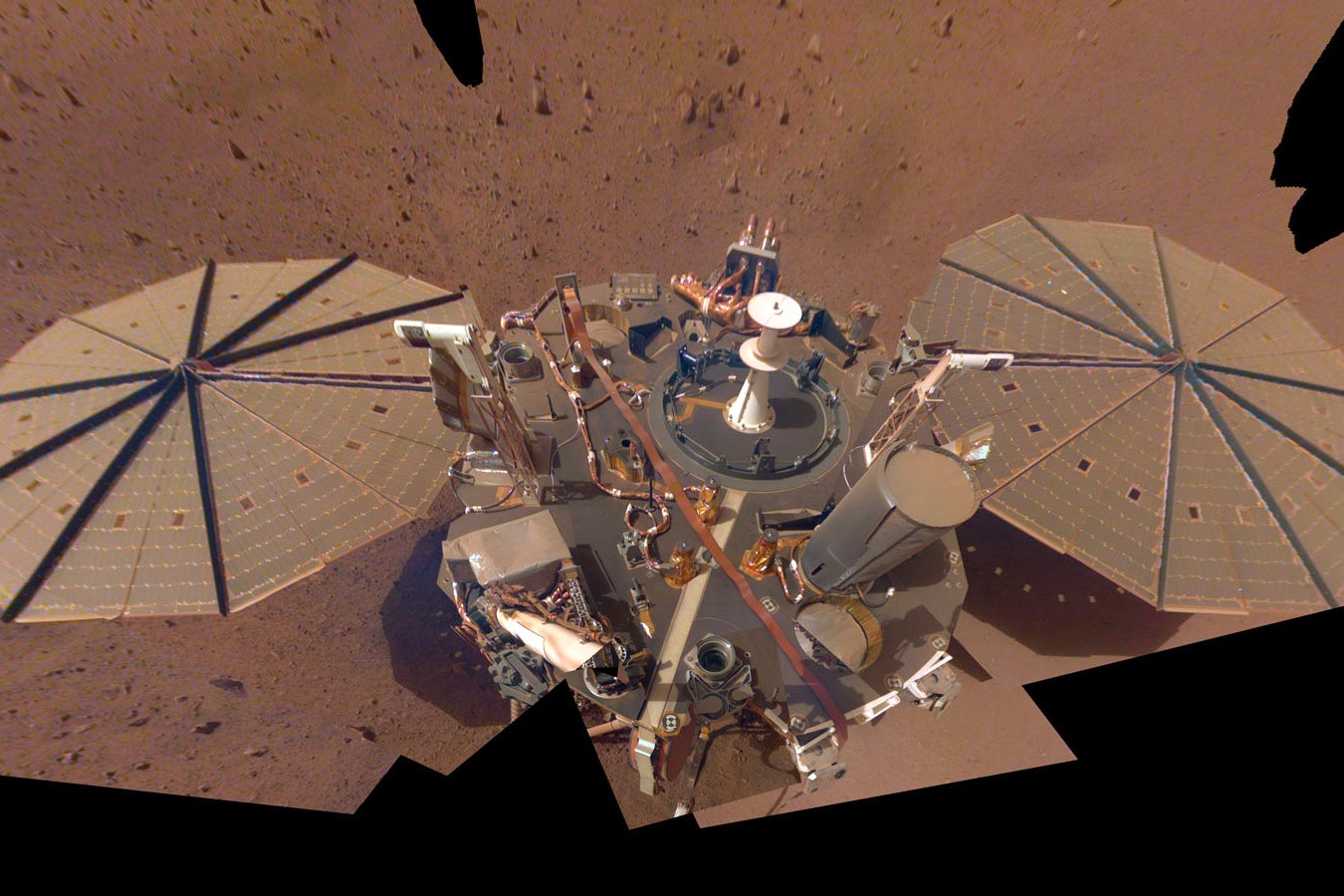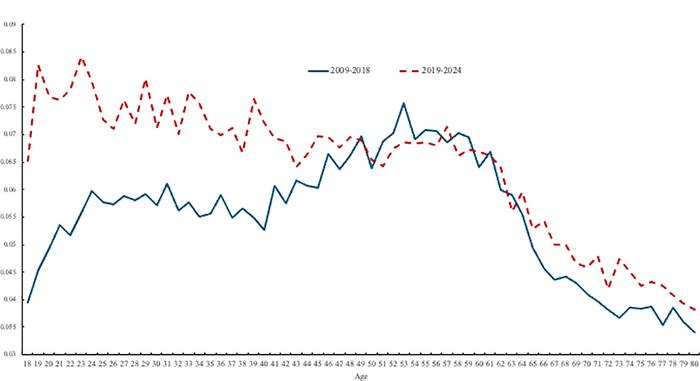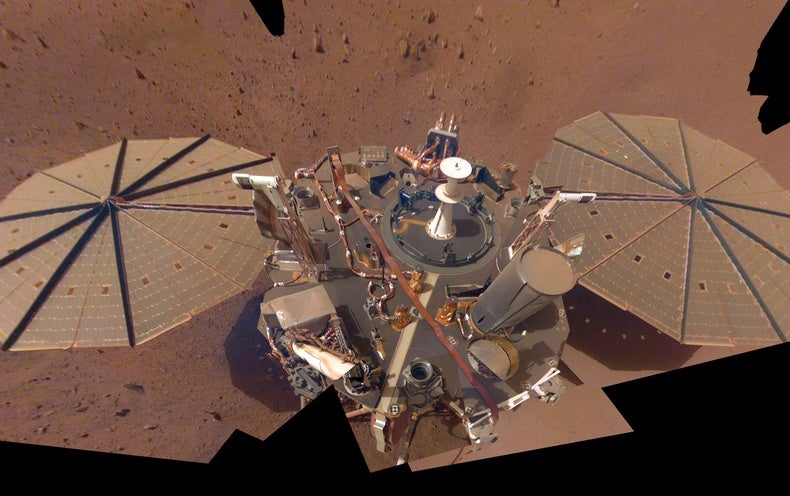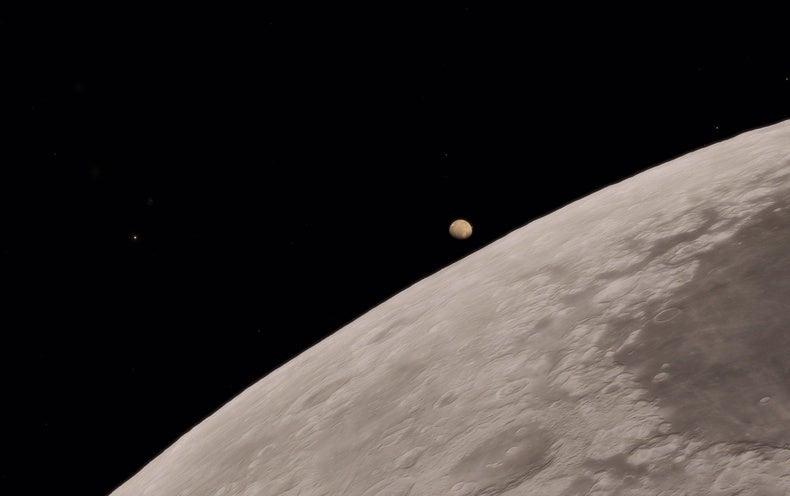
On May 4, three-and-a-half years into its mission, NASA’s InSight lander registered the largest “marsquake” ever detected. The magnitude 5.0 quake was nearly 10 times more powerful than the previous record-holding Red Planet temblor, reaching the upper limits of what NASA geologists had dreamed of finding on Mars. And it may prove to be the mission’s swan song.
Less than two weeks after the record-shattering quake, NASA announced that InSight is in trouble—not from seismic activity but from a slowly accumulating layer of rust-red dust on its solar panels. Barring a serendipitous gust of wind to clear the dust, the lander could be dead by early to mid-July. Now NASA engineers are hustling to gather as much data as they can during InSight’s remaining time.
InSight has faced a host of unique challenges since making planetfall on Mars in late 2018. On Earth, geologists usually collect quake data using suites of strategically placed seismic stations that are located in geologically active areas and firmly anchored in the ground to shelter them from the excess vibrations caused by wind, water and people milling around.
In contrast, “on Mars, we only have this one seismometer,” says Ingrid Daubar, a planetary scientist at Brown University, who helped plan InSight’s objectives. That makes it difficult to pinpoint where, exactly, a quake is coming from.
In addition to being restricted a single station, most of InSight’s equipment sits aboveground because burying it would be exceptionally difficult. “You can’t send a backhoe to Mars,” says Suzan van der Lee, a seismologist at Northwestern University, who was not involved with the InSight mission. Even with its wind and solar shields deployed, InSight’s equipment is still prone to picking up noise from natural phenomena that Earth seismometers simply don’t have to deal with.
The mission was equipped with one underground instrument—but unfortunately, it didn’t operate as planned. InSight’s Heat Flow and Physical Properties Package, affectionately dubbed “the mole,” was meant to measure the amount of heat flowing up from deep beneath the planet’s crust. But when the mole was deployed in 2019, it immediately ran into trouble. Mars’s soil turned out to have less friction than InSight’s geologists had planned for, rendering the probe unable to reach its intended depth of about five meters. Instead the mole managed to penetrate a mere five centimeters into the Martian surface.
“Not being able to get that heat flow measurement was probably the biggest disappointment of the mission,” said InSight’s principal investigator Bruce Banerdt in a May 17 press conference.
Nevertheless, InSight has given geologists an unprecedented window into Mars’s internal goings-on. In fact, the mission was successful enough that NASA greenlit a two-year extension after it completed its primary objectives in late 2020. Based on data collected from 1,300-plus marsquakes, scientists now have a more accurate idea of the size and density of the planet’s core, which is larger and less compact than previously thought. And they’ve learned an enormous amount about the mechanisms that drive Mars’s geologic activity.
Quakes on rocky celestial bodies can be triggered by a number of different things: fault lines, volcanoes, meteor strikes and even the influence of other planets. “A lot of moonquakes are due to the gravitational forces that are imposed by the Earth,” van der Lee says.
Roughly 90 percent of quakes on Earth are produced by the movement of tectonic plates, massive slabs of the planet’s lithosphere that slide around atop the semisolid asthenosphere layer and occasionally bump into one another. Earth’s tectonic plates are quite active, especially around certain fault lines (think San Andreas). Pressure builds up beneath the plates along these areas as they grind together and periodically breaks free in the form of tremors.
Mars’s lithosphere lacks these distinct plate boundaries, however. “Instead of having multiple tectonic plates, it’s one kind of thick plate,” Daubar explains. This means that, rather than arising from slipping or grinding plate tectonics, the Red Planet’s seismic activity must emerge from some other mechanism. Scientists now suspect that most marsquakes are triggered by the planet’s gradually cooling interior, which, eons ago, was hot enough to burp up towering supervolcanoes such as Olympus Mons—the tallest and largest peak in the entire solar system. As the ground around these volcanic hotspots settles over geologic timescales, the Martian crust cracks like a fallen soufflé, sending shockwaves rippling through the planet.
Such activity likely caused the magnitude 5.0 quake. Without dramatic tectonic plate movements, planetary scientists don’t think that marsquakes can match the intensity earthquakes, which regularly register magnitude 7.0 and above.
Despite InSight’s successful studies, geologists still have lingering questions about Mars’s seismic activity. For example, earthquakes are sometimes shallow enough to generate undulating “roller coaster” waves on our planet’s surface. “We’ve not really seen those on Mars yet,” van der Lee says. “And it’s not entirely clear why.” And where, exactly, the recent massive marsquake originated is still unclear.
But most likely those questions will have to wait at least until—or if—the European Space Agency’s ExoMars rover mission takes off. InSight’s probable expiration date is looming as its solar panels fail because of the dust. The experiment normally requires 5,000 watt-hours per Martian day to operate. “Today we’re at about a tenth of that available power,” said Kathya Zamora Garcia, a systems engineer at NASA’s Jet Propulsion and InSight’s deputy project manager, at the May 17 press conference. ExoMars, which was slated to take off later this year, is also equipped with a seismometer. Unfortunately, the project has been indefinitely grounded by Russia’s invasion of Ukraine, leaving InSight with no clear successor.
It’s possible that a whirling dust devil—a common Martian phenomenon—will come along and blow the panels clean. Such events kept NASA’s Spirit and Opportunity rovers alive for years beyond their planned three-month lifetime. That possibility is looking increasingly remote, however. “Maybe we’ll get a nice thick dust devil and we’ll have enough power to keep going for a while,” Daubar says. “But we haven’t seen too much of that yet.”
Until then, the InSight team plans to keep squeezing as much seismic data out of their lander as possible. And the researchers will continue to study all the observations it has already sent back for years to come. Daubar sees this as a bittersweet end and an exciting beginning rolled together. “For planetary scientists, this is where it’s at.”



























































